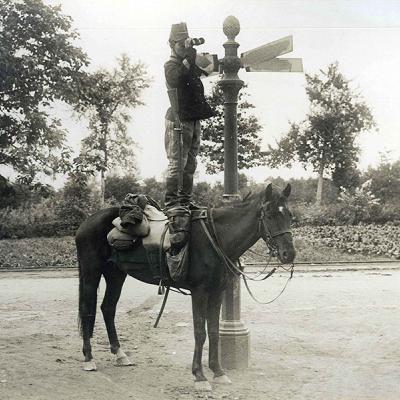The Cavalry
When World War I breaks out, the Belgian army has ten cavalry regiments. A regiment is allocated to each army division :
the 1st Lancers Regiment to the 4th Army Division
the 2d Lancers Regiment to the 3d Army Division
the 3d Lancers Regiment to the 1st Army Division
the 1st Light Cavalry Regiment to the 6th Army Division
the 2d Light Cavalry Regiment to the 5th Army Division
the 4d Light Cavalry Regiment to the 2th Army Division
The regiments are in charge of reconnaissance missions for each army division.
The cavalry division, consisting of two brigades, receives the staff of the four remaining regiments (1st Guides Regiment, 2d Guides Regiment, 4th Lancers Regiment, 5th Lancers Regiment).
The Guides and Lancers Regiments are armed with a short version of the Mauser 1889, a sabre and a lance. Uniforms of the cavalry vary a lot and are totally inappropriate for the new type of warfare.
On August 4th 1914, the 2d Lancers Regiment carries out a reconnaissance mission near Thimister. Horseman Antoine Fonck is the first Belgian soldier to fall. The next day, the first Belgian officer, commander Menten de Horne from the 2d Lancers, is killed in Plainevaux.
From August 1914 to November 1914, the cavalry regiments take part in the following battles :
- Battles of Orsmaal and Halen
- Defence of the fortified positions of Liège, Namur and Antwerp.
- Sorties from Antwerp.
- Defence of the Scheldt
- Withdrawal to the Yser
- Battle of the Yser
The floods in the Yser Plain mark the beginning of the trenchwar. From that moment on, all units of the cavalry are mainly used in the infantry.
In May 1915, khaki uniforms and Adrian helmets are provided to the units.
Between March 6th and 18th 1918, the sector of the cavalry division is the scene of violent fights, known as the Battle of Reigersvliet.
After the failure of the last big German offensive, the allies are ready to throw all their troops into the trench war. The Belgian army, under the command of King Albert I, is integrated to the “Army Group Flanders”. The cavalry can redeploy its horses again, and on October 15th, they set off in pursuit of the the withdrawing German troops.
On October 19th 1918, the 1st Guides Regiment launches an offensive against the German troops in the hamlet of Burkel. This is the last cavalry charge on the western front.






